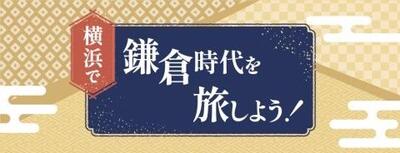- Yokohama-shi Top Page
- Minami Ward Top Page
- Introduction of the ward
- Overview of Minami Ward
- Let's travel around the Kamakura period in Minami Ward
Here's the text.
Let's travel around the Kamakura period in Minami Ward
There are many historical spots in Minami Ward, including Komyoji Temple, the oldest temple in Yokohama. In connection with the broadcast of the 2022 NHK taiga drama "13 people in Kamakura-den", we will introduce places related to Minami Ward, entitled "Let's Travel the Kamakura Period in Minami Ward."
Last Updated October 31, 2022
- 1 Temples and shrines in Minami Ward, which are related to the Kamakura period.
- 2 Let's actually go!
- 3 spill tales
Why don't you tour the places related to Minami Ward with a guide? (Application has been closed.) (Participation fee is free)
Date and time of implementation
Saturday, November 5 9:30 am to 1:00 pm (planned)
Course Overview
Municipal Subway Blue Line Maita Station (meeting) ⇒ Muryoji ⇒ Wakamiya Hachimangu ⇒ Ooka District Center (break)
⇒ Monument of Kamakura Kaido ⇒ Komeiji Shopping Street ⇒ Komyoji ⇒ Jorenji ⇒ Keikyu Main Line Idogaya Station (scheduled to be dissolved)
Targets
Those who can walk about 5 to 6 km (elementary school students and above: elementary school students must be accompanied by parents)
Capacity
30 people (lottery) ※A guide will guide you to a group of about 5 to 7 people.
Application deadline (Application has been closed.)
Friday, October 21, 2022 (must arrive)
Guide
Yokohama Minami Guide Volunteer Association
How to apply (Application has been closed.)
◆Electronic application
https://shinsei.city.yokohama.lg.jp/cu/141003/ea/residents/procedures/apply/0bda94a8-ff11-4461-8a42-3cdcb40023af/start (external site)
◆Fill out the postcard or fax with 1-4 and go to the application address.
①Name: Address, 3 Phone number, 4's
※Personal information will be used only for the implementation and operation of this project.
Notes
・The lottery results will be announced by mail by October 31, 2022 (Monday).
・Light rain (cancelled in stormy weather) ※In case of cancellation, we will post the cancellation on the Minami Ward Web page around 16:00 the day before.
Handbill
1 Temples and shrines in Minami Ward, which are related to the Kamakura period.
Land related to Yoritomo Minamoto
Gumyoji
This temple is said to be the oldest temple in Yokohama, founded in 737, and Yoritomo Minamoto became a prayer place for the Shogunate and flourished under the protection of the Kamakura Shogunate. It is also known as the 14th place of the Bando 33 Kannon Tour, which is said to have been established in the Kamakura period. The eleven-faced Kanzeon Bodhisattva statue of the main statue is designated as an important cultural property of the country.
_________________________
Address: 267, Gumyojicho, Minami-ku, Yokohama-shi
Access: A 2-minute walk from Komyoji Station on the Keikyu Line.
5-minute walk from Komyoji Station on the Yokohama Municipal Subway.
_________________________
Wakamiya Hachimangu Shrine
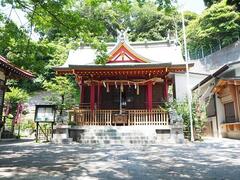
When Yoritomo Minamoto opened the Shogunate in Kamakura, it is said that it was one of several temples and shrines built to protect the land of Yokohama, which is the demon gate of Kamakura, and was founded as a separate shrine of Wakamiya Hachimangu Shrine, the precincts of Tsurugaoka Hachiman-gu Shrine. I am.
_________________________
Address: 1-5-1 Ooka, Minami-ku, Yokohama
Access: 9-minute walk from Komyoji Station on the Yokohama Municipal Subway.
_________________________
Land related to Masako Hojo
Jorenji Temple
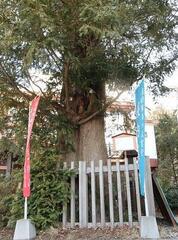
It is said to have been erected by Masako Hojo, the wife of Yoritomo Minamoto.
In the precincts, there is a kaya tree that is handed down to Masako's hand-planted, and a well that is said to have been used by Masako for makeup.
_________________________
Address: 33-1, Idogayakamimachi, Minami-ku, Yokohama-shi
Access: 8-minute walk from Komeiji Station on the Keikyu Line.
9-minute walk from Idogaya Station on the Keikyu Line.
_________________________
Click the banner for places other than Minami Ward.
2 Let's actually go!
This is a column that introduces the highlights of the neighborhood along with a simple map. Why don't you use it as a reference for walking in the city?
Kamakura Highway Edition
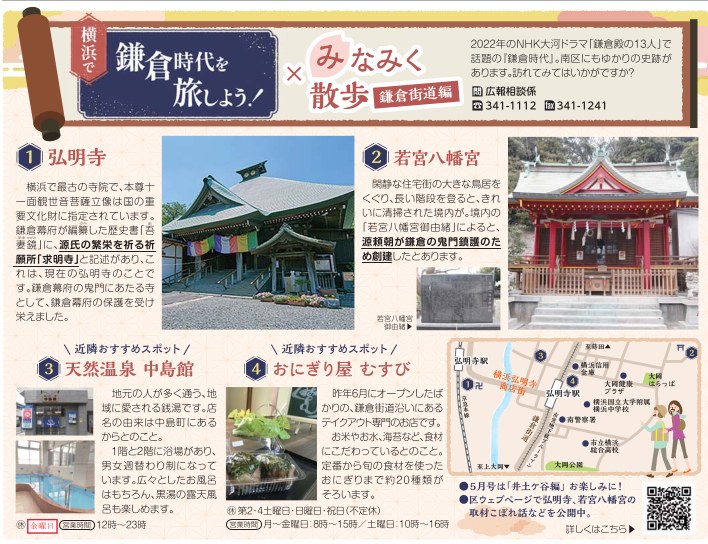
This is the content published in the April 2022 issue of the Public Relations Yokohama Minami Ward.
Idogaya edition
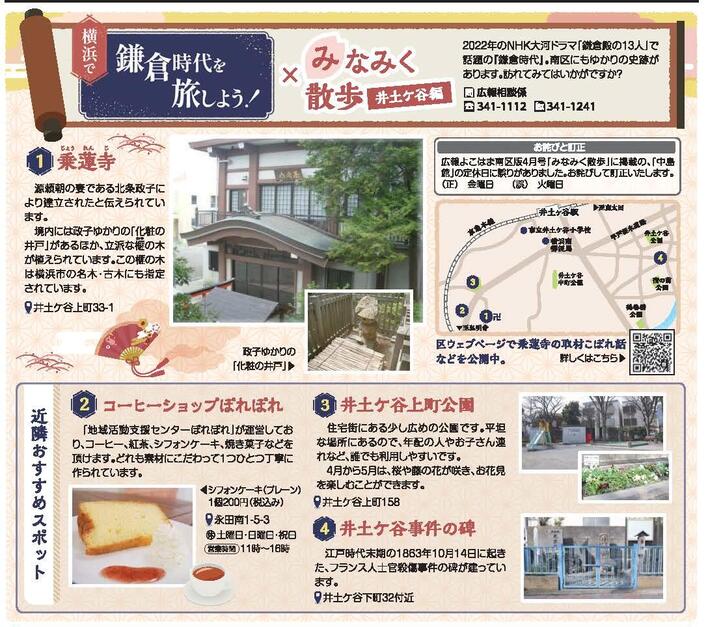
This is the content published in the May 2022 issue of the Public Relations Yokohama Minami Ward.
3 spill tales
In creating the article, we will tell you stories taught by temples and shrines related to the Kamakura period, and spill stories such as impressions when the ward office visited the site.
Gumyoji
※A fee of 500 yen will be charged when visiting the main hall or the main hall.
※You will not be able to see it during the memorial service.
Pay attention to the floorboard inside the main hall!
When you step on the floorboard inside the main hall, you can clearly feel the unevenness of the floor on the soles. This is because in an era when "canna" for cutting boards is not common, it is an old material that was flattened using a tool called "chona". I feel the history!
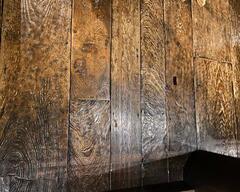
Floorboard of chona carving
The tiles from the Nara period remain.
Inside the main hall, the tiles (den: Nara period) used for Kannondo used in the past are preserved. Because there is a trace of the cloth, it is called a cloth tiles, and it seems that it was used only for limited buildings such as administrative agencies and temples. It is said that the tiles were burned to Nagata-cho, Minami-ku today.
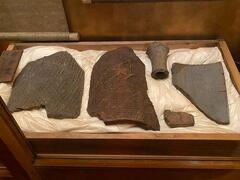 Cloth tiles
Cloth tiles
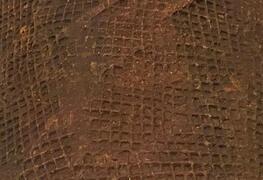 You can clearly see the pattern of the fabric.
You can clearly see the pattern of the fabric.
A special statue of Kanzeon Bodhisattva
The eleven-faced Kanzeon Bodhisattva statue of the main statue is a Buddha statue carved out of a single piece of wood and is an important cultural property designated by the country. It is carved with a technique of intentionally leaving the flea traces called nata carving, and is famous as a typical example of carving left in the Kanto region. It is also characterized by the fact that the right hand is marked with the eradication of the plague because it was produced in the hope of eradication of the plague.
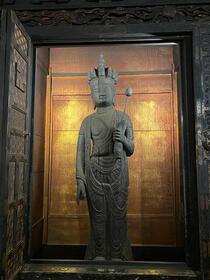
Statue of the eleven-faced Kanzeon Bodhisattva of the main statue
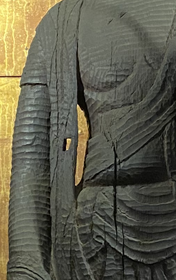
You can see flea marks when you come close.
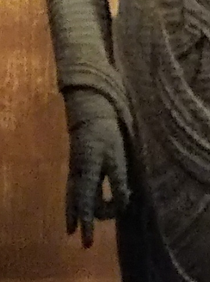
The right hand is a sign of extermination of the plague.
It is also the 14th place of Bando 33 Kannon Tour
Bando 33 Kannon has 33 temples in the Kanto region in a concentric circle centered on Kamakura, and Komyoji is the 14th place.
Bando 33 Kannon seems to have Yoritomo Minamoto, who worshiped Kannon, chose Kannon Sacred Ground in Bando (the area east of Hakone and Usui Pass) following the 33 Kannon tour in western Japan. .
In the past, Kanazawa Road used to pass!
The road that intersects on the way from Komyoji to Yokohama Komeiji Shopping Street was the former Kanazawa Road. Kanazawa Road is an old road that breaks up from Hodogaya-juku on the Tokaido and leads to Kanazawa Hakkei, Uraga and Kamakura. Now, the narrow road used to be the main road!
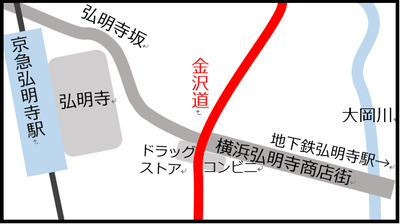
Wakamiya Hachimangu Shrine
※Visitors are free to visit the temple grounds.
A torii gate appears in a residential area!
Let's head to Ooka Health Plaza from Komyoji Subway Station. Proceed while looking at Ooka Health Plaza to your left, turn left at the corner of the next square (Ooka Harappa), and go straight ahead, a torii gate suddenly appears in a residential area. Let's go through the torii gate and go on. The stairs in front of you continue to the precincts.
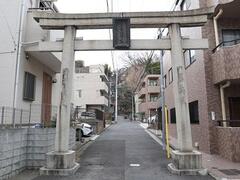 Torii in a residential area
Torii in a residential area
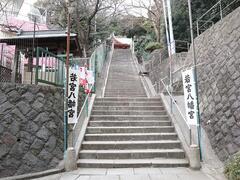 Stairs leading to the precincts
Stairs leading to the precincts
The precincts are beautifully arranged.
When the ward office visited the interview, the precincts were cleaned clean without any fallen leaves. It seems that the local people are cleaning every day. You can feel that it is valued in the community.
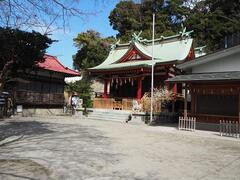
Beautiful sandy grounds
It stands in front of Kamakura.
It is said that the shrines of the shrine are often built south or eastward, but Wakamiya Hachimangu Shrine is said to be located in front of Kamakura (southwest). You can feel the history that it was built to protect Kamakura.
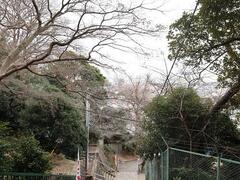 From the precincts, you can see the Kamiooka area.
From the precincts, you can see the Kamiooka area.
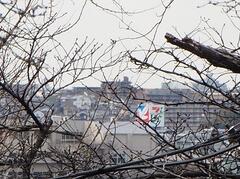 You can see the Ito-Yokado Yokohama Bessho store.
You can see the Ito-Yokado Yokohama Bessho store.
Jorenji Temple
※Visitors are free to visit the temple grounds.
The statue of Masako Hojo is not open to the public, but if you would like to visit, you can call the temple in advance and guide you.
A well with makeup related to Masako Hojo and a kaya tree
There is a well on the grounds that Masako is said to have used it for makeup. There are legends that high quality water has come out and have never died in any sunshine.
There is also a fine kaya tree with a diameter of more than 1.2m. This kaya tree is designated as a famous tree Furuki in Yokohama City, and is also handed down by Masako.
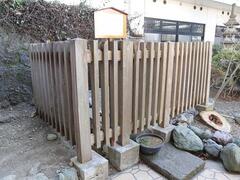 A well for makeup
A well for makeup
 A kaya tree
A kaya tree
Statue Masako Hojo
In the main hall, the statue of Masako Hojo is enshrined. Masako pledged to be a guardian Buddha for women and children, and told me that there was a story that she copied herself on a mirror and carved herself. In addition, they also showed a plate painting (1938), in which Masako carved a Buddha statue by hand carving.
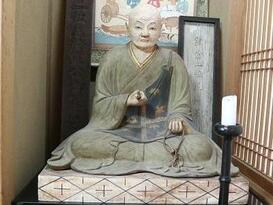 Statue Masako Hojo
Statue Masako Hojo
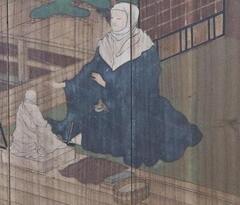 Masako depicted on a board picture
Masako depicted on a board picture
Temples rooted in the community
You will see items donated by local people, such as photographs of old temples that retain the former thatched main hall, stone monuments erected in the Meiji era, and statues of Fudo Myo, which were worshiped at home. Was. I felt that the locals were relied on the temple, and that the temple had been carefully handed down the items.
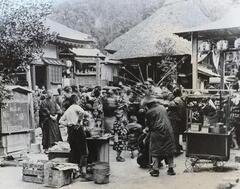
The main hall used to be thatched.
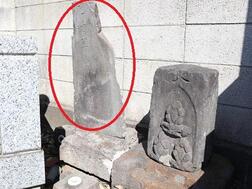
A stone monument built in the Meiji era
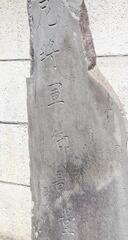
You can see the letters "1881 Nun Shogun Mikagedo"
You may need a separate PDF reader to open a PDF file.
If you do not have it, you can download it free of charge from Adobe.
![]() To download Adobe Acrobat Reader DC
To download Adobe Acrobat Reader DC
Inquiries to this page
Minami Ward General Affairs Department Ward Administration Promotion Division
Telephone: 045-341-1112
Telephone: 045-341-1112
Fax: 045-341-1241
Email address: mn-kusei@city.yokohama.lg.jp
Page ID: 694-137-390










